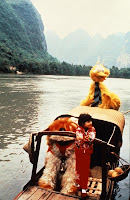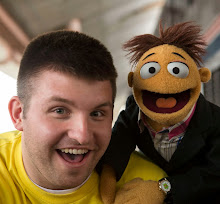Kyle Mahoney - There are many Sesame Street specials, more than I could possibly remember, but two that recently popped into my head were Big Bird in China and Big Bird in Japan. These two specials from the 80's threw Big Bird, accompanied by Barkley, into these two foreign countries. So I will be doing double duty by reviewing both of these specials.
Big Bird in China
 While walking through Chinatown, Big Bird learns of the legendary Chinese bird, the Phoenix. Wanting to create a better friendship between American and China, Big Bird decides to find the Phoenix and travels to China and brings Barkley. To find the Phoenix they must travel to four different landmarks and at each landmark they must find the Monkey King and get a clue that will eventually lead them to the Phoenix. While hopelessly searching for The Great Wall of China ("There must be a zillion walls in China!"), they meet a young girl named Xiao Foo who decides to help them by leading them to the landmarks and translating the Monkey King's clues. After many misadventures, they finally reach the home of the Phoenix. Big Bird explains to the Phoenix that he wanted to learn all about China from her, but he learned so much just by trying to find her, which was her exact intent.
While walking through Chinatown, Big Bird learns of the legendary Chinese bird, the Phoenix. Wanting to create a better friendship between American and China, Big Bird decides to find the Phoenix and travels to China and brings Barkley. To find the Phoenix they must travel to four different landmarks and at each landmark they must find the Monkey King and get a clue that will eventually lead them to the Phoenix. While hopelessly searching for The Great Wall of China ("There must be a zillion walls in China!"), they meet a young girl named Xiao Foo who decides to help them by leading them to the landmarks and translating the Monkey King's clues. After many misadventures, they finally reach the home of the Phoenix. Big Bird explains to the Phoenix that he wanted to learn all about China from her, but he learned so much just by trying to find her, which was her exact intent.Some of the many things that the viewer learn in this special are some basic Chinese words and phrases, some different styles of Chinese dancing, and the legend of the Phoenix. How the folklore of China is Big Bird's main reason for heading to China really helps progress the story. Surprisingly Big Bird becomes very frustrated with the constant shenanigans of the Monkey King and even says "Barkley, sick 'em" and soon after threatens the king by saying "THAT'S IT! Put up your dukes I'm gonna..." He becomes exasperated very easily with the Monkey King's cryptic clues and the viewer (at least this one) became exasperated with Big Bird's constant doubt of the entire venture.
 But the reason for Big Bird's doubt could be to have the viewer encourage him, which is what Xiao Foo does--she reassures him that everything will end well. In regards to Xiao Foo, I can't help but wonder where are her parents? And how does she know exactly where all of these landmarks are at such a young age? A very brief side story to Big Bird's adventure is Telly and Oscar literally digging their way to China, and upon getting there Oscar declares "Yeah well... it doesn't look like much to me, let's go home."
But the reason for Big Bird's doubt could be to have the viewer encourage him, which is what Xiao Foo does--she reassures him that everything will end well. In regards to Xiao Foo, I can't help but wonder where are her parents? And how does she know exactly where all of these landmarks are at such a young age? A very brief side story to Big Bird's adventure is Telly and Oscar literally digging their way to China, and upon getting there Oscar declares "Yeah well... it doesn't look like much to me, let's go home." The special includes a few original songs which are cute, but really don't move the story along with the exception of "Ni Hao," as Xiao Foo teaches Big Bird how to say "Hello," "I Love You," and his own name! Other songs include "In China!" in which the Sesame gang helps sing Big Bird off, "Song of the Monkey King" which just talks about how crazy and tricky the Monkey King is, and lastly "The Phoenix Song," a song that the Phoenix sang in her legend to convince evil spirits that China was not hers, but theirs too.
The special includes a few original songs which are cute, but really don't move the story along with the exception of "Ni Hao," as Xiao Foo teaches Big Bird how to say "Hello," "I Love You," and his own name! Other songs include "In China!" in which the Sesame gang helps sing Big Bird off, "Song of the Monkey King" which just talks about how crazy and tricky the Monkey King is, and lastly "The Phoenix Song," a song that the Phoenix sang in her legend to convince evil spirits that China was not hers, but theirs too.All in all, the special does what it needs to do, teach the viewer about the culture of China, through humor and storytelling. Though it only shows more suburban and rural areas of China as opposed to city life, more of the ancient and deep rooted ancestries are explored. Big Bird in China was a great way for Sesame Street to truly start to branch off into other countries.
Big Bird in Japan
 In 1989, Big Bird and Barkley traveled to the land of the rising sun. While in Tokyo, the two are left by their tour group, who are leaving for Kyoto on the 15th. Big Bird becomes extremely worried and extremely homesick. Suddenly, a young woman appears and tells Big Bird that she overheard his problem and also needs to be in Kyoto by the 15th. Big Bird soon learns that his new friend shares the same name as the fabled Bamboo Princess: Kaguya-Hime. By the end of the special Kaguya-Hime parts ways with Barkley and Big Bird; who now claims "I'm homesick for Japan, and I haven't even left yet!" Big Bird later realizes the possibility that his friend IS the Bamboo Princess and rushes off to see her one last time, but is too late. As he and Barkley relax on the plane Big Bird thinks back and realizes how silly he was being thinking that the Bamboo Princess was real.
In 1989, Big Bird and Barkley traveled to the land of the rising sun. While in Tokyo, the two are left by their tour group, who are leaving for Kyoto on the 15th. Big Bird becomes extremely worried and extremely homesick. Suddenly, a young woman appears and tells Big Bird that she overheard his problem and also needs to be in Kyoto by the 15th. Big Bird soon learns that his new friend shares the same name as the fabled Bamboo Princess: Kaguya-Hime. By the end of the special Kaguya-Hime parts ways with Barkley and Big Bird; who now claims "I'm homesick for Japan, and I haven't even left yet!" Big Bird later realizes the possibility that his friend IS the Bamboo Princess and rushes off to see her one last time, but is too late. As he and Barkley relax on the plane Big Bird thinks back and realizes how silly he was being thinking that the Bamboo Princess was real.While Big Bird is traveling with Kaguya-Hime she teaches him many things, such as simple Japanese phrases (similar to what Xiao Foo did in China), the tradition of bowing to show respect, and what a Shinkansen or Bullet Train is. In this special, Big Bird is driven by needs of survival rather than just wanting to meet part of the native folklore. One thing in regards to the folklore that I like is that Big Bird doesn't go looking for it, he just gets wrapped up into it. Also, in this special Big Bird is much more positive about being in Japan and believes he'll get home, as opposed to his constantly irritated state in China.
 This special also features new original songs that do provide a better use for the story. "Ichi Ni San" teaches Big Bird and the viewer how to count to three, say good morning, thank you, and goodbye. "We're Off to Kyoto" is a sillier song about how excited they are about going to Kyoto which features one of the greatest lyrics in mankind: Big Bird sings "I've got feathers, he's got fleas" and Kaguya-Hime responds "I speak Japanese." Other songs include "Moon Moon" in which Kaguya-Hime laments about being the Bamboo Princess and having to return to the moon, and "Homesick," where Big Bird sings about missing home. An important scene is when Big Bird is dragged into a school and is shown the play of the Bamboo Princess. The story is narrated by Pat Morita (Mr. Miyagi from The Karate Kid) which tells of the moon giving birth to a child and placing her in a golden stalk of bamboo. After growing up the now young woman must leave Japan and return to the moon.
This special also features new original songs that do provide a better use for the story. "Ichi Ni San" teaches Big Bird and the viewer how to count to three, say good morning, thank you, and goodbye. "We're Off to Kyoto" is a sillier song about how excited they are about going to Kyoto which features one of the greatest lyrics in mankind: Big Bird sings "I've got feathers, he's got fleas" and Kaguya-Hime responds "I speak Japanese." Other songs include "Moon Moon" in which Kaguya-Hime laments about being the Bamboo Princess and having to return to the moon, and "Homesick," where Big Bird sings about missing home. An important scene is when Big Bird is dragged into a school and is shown the play of the Bamboo Princess. The story is narrated by Pat Morita (Mr. Miyagi from The Karate Kid) which tells of the moon giving birth to a child and placing her in a golden stalk of bamboo. After growing up the now young woman must leave Japan and return to the moon.Personally I prefer Big Bird in Japan to Big Bird in China due to its stronger character development, not only for Big Bird, but for his sidekick. Not that China is a bad special, I just feel like Japan is structured better. Both are incredibly educational if you ever want to teach young children about these amazing countries. It's great to immerse children in different cultures and Big Bird is a great way to introduction to the world around us.
The Muppet Mindset by Ryan Dosier, muppetmindset@gmail.com




















Big Bird in China is very dear to me. I consider it to be at par with Follow that Bird.
ReplyDelete